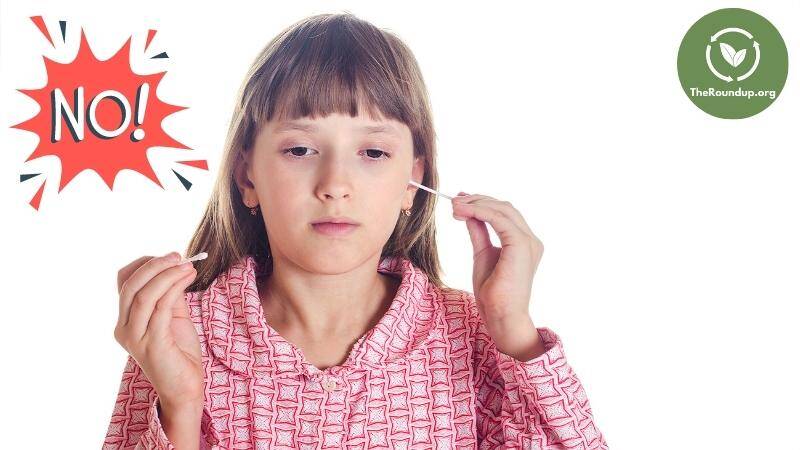
I've had waxy ears since childhood, so over the years, I’ve become something of a natural expert on the topic of earwax removal.
Earwax is a natural substance that helps protect the ear canal. But sometimes too much earwax can build up, which can cause problems like hearing loss, ringing in the ears, and infection.
If like me, you also have a lot of earwax buildup, you may need to remove it. Many people do this using an over-the-counter product like Q-Tips.
Big mistake! Most people don't realize that this can do far more harm than good.
There's no way I would allow a Q-Tip anywhere near mine or my family's ears!
In this article, I’ll explain why that is, and show you what to use instead of Q-tips.
Contents
Q-Tips are a brand of cotton swab. These are small pieces of cotton attached to a thin paperboard, wooden, or (in some cases) plastic stick.
They’re designed for cleaning things like computers, keyboards, and sustainable makeup applicator brushes, but they’re also often used for earwax removal.
This is because they’re cheap, easy to find, and most people already have them in their homes.
Normally when I advise against using a particular product or brand, it's because of its environmental impact.
But actually, that's not the case here.
Unlike some other brands of cotton swabs, many of which are made from single-use plastic, Q-Tips actually aren't that bad for the environment.
Needless to say, the brands that use plastic sticks should be avoided at all costs. You do not want to be adding to the global plastic waste problem.
But according to the manufacturer, these days a Q-Tip is mostly made from sustainable materials.
They are biodegradable and compostable, and the packaging is partially recyclable. So they can, in theory, be a part of your eco-friendly bathroom.
They are not, however, the best choice for earwax removal.

Growing up, my mom used to love telling me, “never put anything smaller than your elbow in your ear”. And the Clinical Practice Guideline (Update): Earwax (Cerumen Impaction) report agrees.
You should never use Q-Tips to remove earwax because they can push the wax further into your ear canal.
This can cause a blockage, leading to hearing loss, tinnitus, and infection.
Q-Tips can also damage the delicate skin in your ear canal, which can lead to pain, irritation, and even bleeding.
They’re too small and stiff to be used safely in such a delicate area.
Q-Tips should also be kept away from babies and children.
They’re more likely to shove the Q-Tip too far into their ear canal, which can cause severe damage to sensitive skin.
This 2011 study highlights the dangers: “The use of cotton buds inside ears has widely been condemned worldwide by otolaryngologists. This is due to well documented complications including trauma, impacted ear wax, infection, and retention of the cotton bud. The most common mode of accidental penetrating ear injury in children is cotton-bud induced”.
If you have a baby or child with a severe earwax buildup that you can’t safely remove with one of the methods below, it’s best to take them to the doctor so they can remove it safely.
There are several ways to safely and effectively remove earwax without using Q-Tips:
If you’re unsure about how to remove earwax safely, or if you think you may have an earwax blockage, it’s best to see a doctor.
They can examine your ears and provide the best treatment course.
One of the best things you can do for your ear health is to just leave your earwax alone.
Your body naturally produces earwax to protect your ears from dirt, dust, and other harmful particles.
Earwax only becomes a problem when it’s produced in excess or if it gets pushed too far into the ear canal.
If you have gray or black earwax, it usually means there is a buildup of dust in your ear. If you’re also experiencing hearing loss, this could be a sign of impacted earwax.
Your doctor can safely remove the blockade and provide tips on how to prevent this in the future.
Healthy dry earwax often falls out of the ear more readily than wet earwax. It’s also more successful at preventing infections.
However, cleaning your ears is also critical since dry wax flakes might accumulate over time and cause an obstruction.
Ear infections are a common cause of itchy ears. Bacteria and viruses are to blame, particularly when you have a cold, the flu, or allergies.
Swimmer’s ear is one variety that occurs when water remains in your ear following a swim. Too much dampness erodes the natural barrier provided by your ear canal’s outer layer of protection against bacteria.
If you have an ear canal infection, your doctor will likely prescribe antibiotics or recommend over-the-counter options.
In the meantime, you can use a warm compress to soothe the itch and apply topical corticosteroids to reduce swelling. Never put anything in your ear to scratch it, as this could worsen the irritation or lead to an infection.
While you can’t always prevent ear infections, there are steps you can take to reduce your risk. These include:
Ear wax removal is not always essential for maintaining good ear health. In fact, leaving it alone can often bring additional benefits.
General and regular ear cleaning is usually enough for most people.
However, if you need to remove excessive earwax from your ear canals, NEVER reach for the cotton tips; there are much better alternatives that won’t push the wax deeper and damage your ears.
So, the next time you need to remove ear wax, ditch the cotton tips and try one of the safer methods mentioned in this article instead. Your ears will thank you!
Do you have a favorite Q-Tip alternative to prevent ear problems? Do you swear by hydrogen peroxide to clean your ears? Or do you prefer a few drops of natural oil on a cotton ball to clean excessive ear wax from your outer ear and eardrum?
Have you ever visited an ear, nose, and throat doctor for a professional ear canal clean? Drop me a line and let me know.

